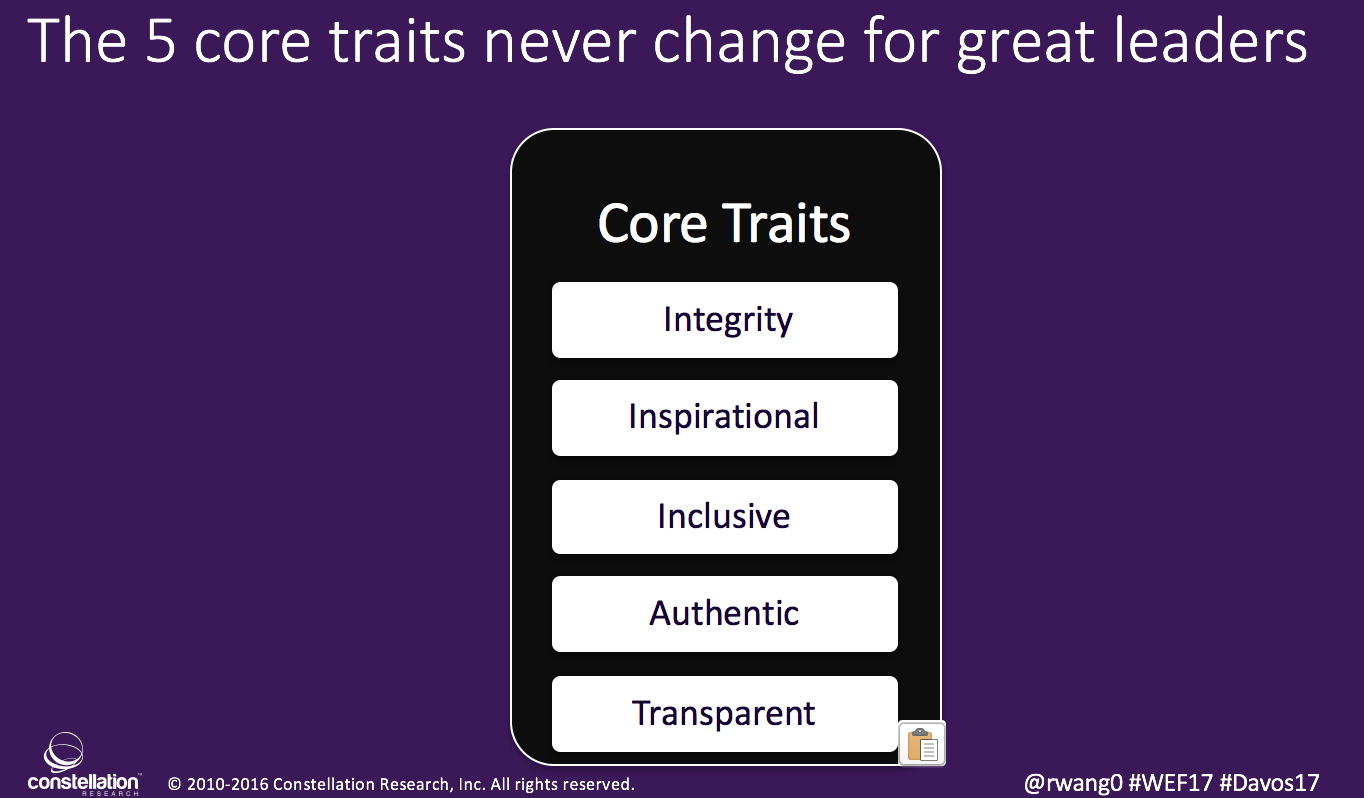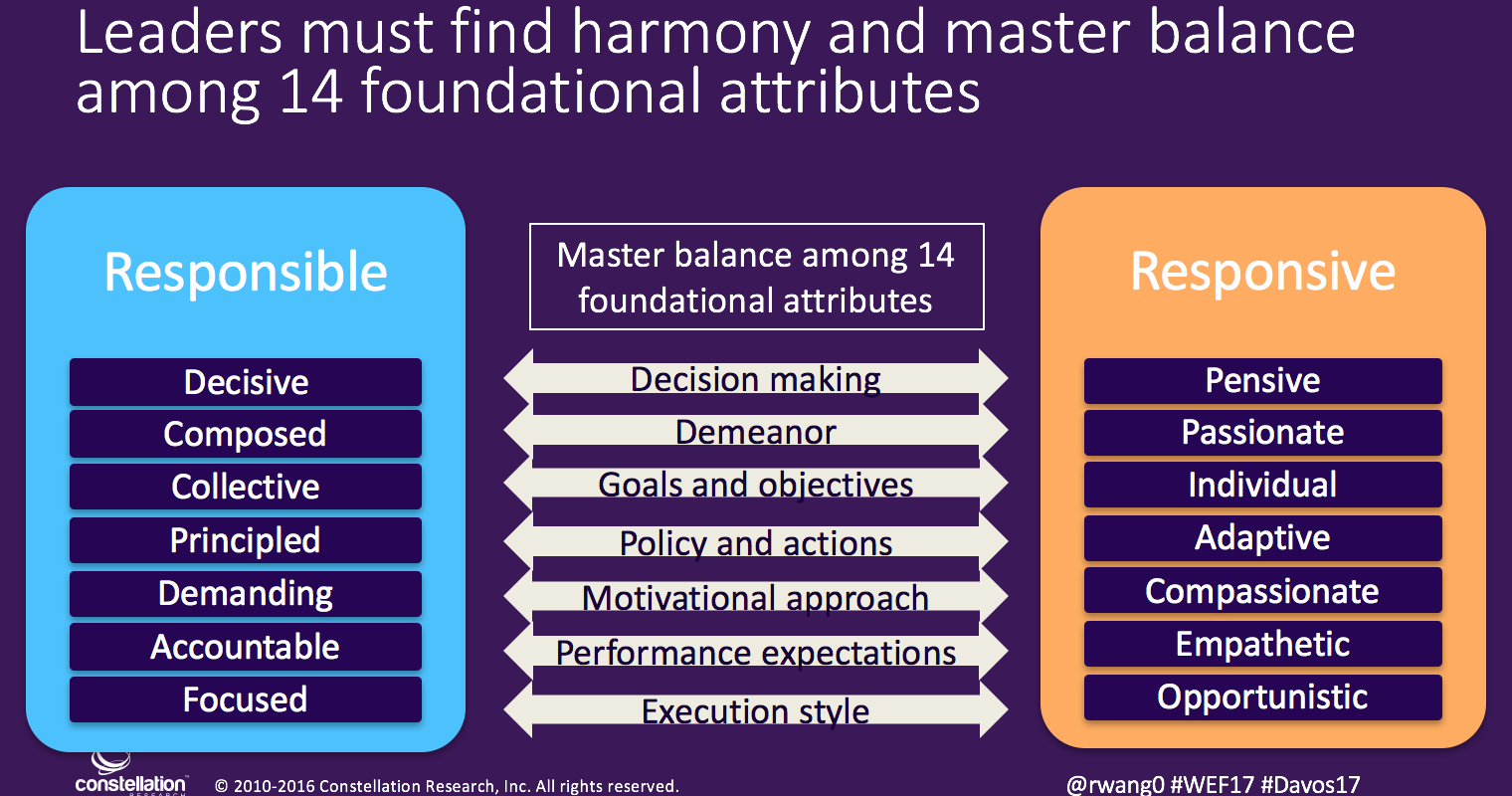
Monday's Musings: Dynamic Leadership - A Responsive And Responsible Approach #Davos #WEF17

Today's Leadership Models Fail To Address Responsive And Responsible Leadership
The World Economic Forum kicks off January 17th to 20th in Davos-Klosters, Switzerland. As the global theme for the annual meeting, responsive and responsible leadership begins a lofty conversation about the qualities required to bring generations together, create inclusiveness in growth opportunities, and to bridge cultural and economic divides. With the global system challenged by a confluence of political, economic, societal, technological, environmental, and legislative forces, executives seek leadership models that reflect this responsive and responsible paradigm. Moreover, the impact of technologies such as artificial intelligence and robotics on the future of work plays a key driving factor in the development of policies that address humanity in a digital age.
This macro pressure at the global scale impacts the business world from many fronts. In fact, the digital disruption organizations face from non-traditional competitors, emerging technologies, and new disruptive business models requires a different type of leadership to manage the pace of change required not only for survival, but also for cultural agility. Past models of leadership play a key role, yet the continual over and under emphasis of one type of leadership design and style no longer is relevant for the challenges ahead.
Dynamic Leadership Provides A Responsive And Responsible Framework For A World Of Digital Transformation
One solution is a dynamic leadership approach. By identifying the immutable core traits and modulating the balance in foundational attributes of leadership, executives can achieve a contextually right time approach. Immutable core traits must be mastered and cannot be neglected. Foundational attributes require more finesse and self-awareness of contextual relevance in balancing out responsive and responsible traits. This dynamic style of leadership allows a framework to balance out traits as needed to achieve the mission, goals, and objectives over a defined period of time.
Five Immutable Core Traits Never Change For Great Leaders
Integrity, inspiration, inclusiveness, authenticity, and transparency form the five immutable core traits of leadership. These immutable traits do not change with time or the business trends at hand. Great leaders hone and refine these traits as part of their development and incorporate these traits into their DNA (see Figure 1.)
Figure 1. Five Immutable Core Traits Never Change For Great Leaders

- Integrity. Leaders must have strong moral principles, demonstrate honesty, and uphold honor.
- Inspiration. Leaders must stimulate and draw folks towards ideas, concepts, and actions.
- Inclusiveness. Leaders must bring people together from different backgrounds and points of view to create equal opportunities.
- Authenticity. Leaders must reflect a genuineness in who they are and what they stand for.
- Transparency. Leaders must be accountable and provide clarity on decisions and actions
Seven Dimensions In The Art Of Leadership Require A Balance Of Fourteen Attributes
The art of leadership requires the balance and mastery of fourteen foundational attributes. Each of these 14 attributes on their own have often been used to simplify and describe traits of a great leader. For example, great generals have been known to be demanding. Leaders of freedom movements have been shown to be principled. However, other great leaders have won over folks by their compassion or have been known to be quite adaptive. As evident, this one dimensional approach to leadership often leads to imbalanced description of what it takes to succeed at that point of time and does not reflect the reality of the current or future environment.
A more balanced or Yin-Yang approach segments attributes into responsible and responsive dimensions that consider decision making, demeanor, goals and objectives, policy and actions, motivational approach, performance expectations, and execution style. Responsible attributes include principled, focused, accountable, decisive, composed, demanding, and collectivism. Meanwhile, the responsive attributes include adaptive, aware, empathetic, pensive passionate, compassionate, and individualism.
By taking a dynamic leadership approach, leaders can account for a more complex reality and attenuate an attribute as needed. These 7 dimensions of leadership include (see Figure 2.):
Figure 2. The Art of Leadership Requires Balancing Fourteen Attributes In Seven Dimensions

- Decision making. In the Decisive versus Pensive decision making process, are rapid and clear decisions more valued than a thoughtful methodology to decision making?
- Demeanor. For Composed versus Passionate demeanor, would a composed presence outweigh a passionate emotional manner?
- Goals and objectives. When thinking about Collective versus Individual goals and objectives, should a leader think about the larger group instead of the individual self-interest
- Policy and actions. In Principled versus Adaptive policy and actions, should leaders be lauded for staying the course or knowing when to make a shift?
- Motivational approach. Does a Demanding versus Compassionate motivational approach require leaders to push hard for more or will reaching out with more compassion result in better esprit de corps?
- Performance expectations. In Accountable versus Empathetic performance expectations, is a broad based policy and results driven style more important than a personalized approach to achievement?
- Execution style. In Focused versus Opportunistic Execution strategy, should we emphasize laser focus on a task or sentient situational awareness?
The Bottom Line: Digital Transformation Requires Dynamic Leadership For Success
As leaders converge at Davos, the call for responsive and responsible leadership will require a new way to approach the timeless topic of leadership. Instead of taking a classical binary or rigid approach, consider the 5 core traits and develop a balance of 14 foundational attributes as a guide to successful and sustainable dynamic leadership (see Figure 3). Success at the leadership level will translate into much broader organizational values and capabilities.
Figure 3. Why Digital Transformation Requires A Dynamic Leadership Model

Your POV.
Are you ready to begin your digital transformation journey? Do you have the right leadership framework? Would you like to join a network of other early adopters? Learn how non-digital organizations can disrupt digital businesses in the best-selling Harvard Business Review Press book Disrupting Digital.
Join like minded folks at the Constellation Executive Network.
Add your comments to the blog or reach me via email: R (at) ConstellationR (dot) com or R (at) SoftwareInsider (dot) org.
- Developing your digital business strategy
- Connecting with other pioneers
- Sharing best practices
- Vendor selection
- Implementation partner selection
- Providing contract negotiations and software licensing support
- Demystifying software licensing
Resources And Related Research
- News Analysis: In Search Of Growth Amidst Digital Disruption
- Event Report: The Weekend Before Davos And The Dawn Of The Fourth Industrial Revolution
- Event Report: The @Wipro @FT Dinner, Man vs Machine, Does It Have To Be Either/Or? #Davos2016 #WEF #WEFTalks
- Event Report: The Future Of Jobs From #Davos16 #WEF
- Event Report: The Transformation of Finance #Davos16 #WEF
- Event Report: A New Platform For The Digital Economy #Davos16 #WEF
- Monday’s Musings: Secrets Behind Building Any AI Driven Smart Service November 28, 2016
- Trends: Five Data Center Trends For 2017 November 12, 2016
- News Analysis: America In An @RealDonaldTrump Era – Everything International Clients Need To Know PESTEL Part 1. November 10, 2016
- Research Summary: Constellation’s AstroChart For Business Trends, Q4 2016 October 18, 2016
- Research Summary: Constellation’s AstroChart For Tech Trends October 17, 2016
- Monday’s Musings: Secrets Behind Building Any AI Driven Smart Service
- Monday’s Musings: Understand The Spectrum Of Seven Artificial Intelligence Outcomes
- Tuesday’s Tip: Seven Factors For Precision Decisions In Artificial Intelligence
- Monday’s Musings: Data – The Foundation Of Real-Time Digital Business
- ‘Monday’s Musings: Who Gets To Be A Chief Digital Officer?
- Monday’s Musings: CXOs Seek Enterprise-Grade Mobile Solutions Despite Seven Barriers August 16, 2016
- Research Summary: [VIDEO] Inside Constellation’s Futurist Framework August 9, 2016
- Best Practices: Five Critical Success Factors To Digital Transformation July 10, 2016
- Monday’s Musings: The Post #BREXIT Analysis, What’s Next? June 27, 2016
- Monday’s Musings: Data – The Foundation Of Real-Time Digital Business May 23, 2016
- Research Summary: The Algorithm of You – How IoT Transforms and Differentiates Customer Experience May 12, 2016
- Research Summary: HOLMES Puts Wipro in the Forefront of Cognitive Computing May 10, 2016
- Research Summary: Why Live Engagement Marketing Supercharges Event Marketing May 6, 2016
- Monday’s Musings: Why Digital Transformation Must Move Beyond The Hiring Of A Chief Digital Officer April 25, 2016
- Monday’s Musings: The Four Personas Of The Modern CMO In A Digital World April 11, 2016
- Monday’s Musings: The Seven Rules For Digital Business And Digital Transformation
- Tuesday’s Tip: Five Steps To Starting Your Digital Transformation Initiative
- Monday’s Musings: What Organizations Want From Mobile
- Research Summary: Economic Trends Exacerbate Digital Business Disruption And Digital Transformation (The Futurist Framework Part 3)
- Research Summary: Five Societal Shifts Showcase The Digital Divide Ahead (The Futurist Framework Part 2)
- Research Summary: Sneak Peaks From Constellation’s Futurist Framework And 2014 Outlook On Digital Disruption
- Research Report: Digital ARTISANs – The Seven Building Blocks Behind Building A Digital Business DNA
- Research Summary: Five Societal Shifts Showcase The Digital Divide Ahead (The Futurist Framework Part 2)
- Research Summary: Next Generation CIOs Aspire To Focus More On Innovation And The Chief Digital Officer Role
- Trends: [VIDEO] The Digital Business Disruption Ahead Preview – NASSCOM India Leadership Forum (#NASSCOM_ILF)
- Harvard Business Review: What a Big Data Business Model Looks Like
- Monday’s Musings: How The Five Consumer Tech Macro Pillars Influence Enterprise Software Innovation
- Tuesday’s Tip: Understand The Five Generation Of Digital Workers And Customers
- Monday’s Musings: The Chief Digital Officer In The Age Of Digital Business
- Slide Share: The CMO vs CIO – Pathways To Collaboration
- Research Summary And Speaker Notes: The Identity Manifesto – Why Identity Is At The Heart of Digital Business
Reprints
Reprints can be purchased through Constellation Research, Inc. To request official reprints in PDF format, please contact Sales .
Disclosure
Although we work closely with many mega software vendors, we want you to trust us. For the full disclosure policy,stay tuned for the full client list on the Constellation Research website.
* Not responsible for any factual errors or omissions. However, happy to correct any errors upon email receipt.
Copyright © 2001 -2017 R Wang and Insider Associates, LLC All rights reserved.
Contact the Sales team to purchase this report on a a la carte basis or join the Constellation Customer Experience
 R "Ray" Wang
R "Ray" Wang R "Ray" Wang
R "Ray" Wang